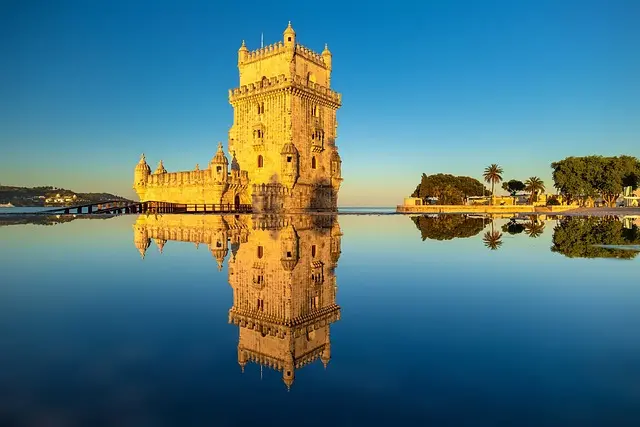
2. Empire Square and Surroundings
Belém Tower
On our second morning in Lisbon, we took Tram 15 from the square near Rossio Square to the Belém area, a route popular with tourists. The tram ride included 15 stops, and most passengers seemed prepared for the journey. A Turkish family we met on board, particularly an older lady with some English proficiency, shared useful tips from their research, such as the correct stop to alight and notable landmarks along the way, including a train station. The ticket price was €2.85 per person, but many, including us, initially didn’t know how to purchase tickets. We later realized tickets were available via onboard vending machines.
An older couple seated across from us advised us to disembark at the farthest scenic stop and walk back toward the city center, covering all the key attractions. This plan proved popular among passengers, with many adopting the same approach. Despite varying levels of English fluency and accents, everyone chatted animatedly, creating a warm and memorable travel experience.
Belém Tower (Torre de Belém) is located about 6 kilometers west of Lisbon’s Old Town, at the mouth of the Tagus River. Historically, this site served as a critical point of defense and a departure port for Portuguese explorers during the Age of Exploration.
Commissioned by King John II of Portugal, the tower was constructed to enhance the empire’s defenses. Over the years, it has served as a customs checkpoint, a telegraph station, a lighthouse, and even a prison for political dissidents during Spain’s rule. Designated a UNESCO World Heritage Site in 1983, Belém Tower is both a symbol of Portugal’s maritime heritage and an architectural marvel.
• Ticket Prices: Adults €6, seniors (65+) €3.
• Impressions: While the tower may seem modest from afar, up close, it is an imposing structure with intricate details.
Monument to the Discoveries
The Monument to the Discoveries (Padrão dos Descobrimentos) stands east of Belém Tower. Built in 1960 to commemorate the 500th anniversary of Prince Henry the Navigator’s death, it celebrates Portugal’s illustrious history of maritime exploration.
• Design:
The monument resembles a grand ship, with detailed sculptures of Prince Henry at the prow and 80 historical figures, including explorers Vasco da Gama, Pedro Álvares Cabral, and Ferdinand Magellan, along with notable generals, missionaries, and scientists. It’s a stunning tribute to the achievements of Portugal during its Age of Discovery, evoking a sense of the era’s glory.
• Nearby:
East of the monument, you’ll find a picturesque marina filled with yachts, adding to the area’s scenic charm.
Empire Square
Directly north of the Monument to the Discoveries lies Empire Square (Praça do Império). At its center is a vast world map set into the ground, meticulously detailing the journeys of Portuguese explorers, including dates, locations, and routes. This grand depiction of Portugal’s seafaring legacy highlights the country’s historical dominance on the global stage, with notable achievements such as reaching Macau in 1514 prominently displayed.
Jerónimos Monastery
North of Empire Square is the Jerónimos Monastery (Mosteiro dos Jerónimos), a masterpiece of Portuguese architecture and a UNESCO World Heritage Site since 1983. Construction began in 1502 to commemorate the opening of the sea route to India, marking the height of Portugal’s maritime and cultural achievements during the Renaissance.
• Interior:
The monastery houses the tombs of iconic figures such as explorer Vasco da Gama and poet Luís de Camões. It also serves as a resting place for other prominent national figures.
• Visiting:
The monastery’s interiors are open to visitors, offering a glimpse into Portugal’s artistic and architectural legacy from the Age of Discovery.
Exploring the Belém area provides an enriching journey through Portugal’s golden age of exploration, blending historical significance with breathtaking views of the Tagus River.
